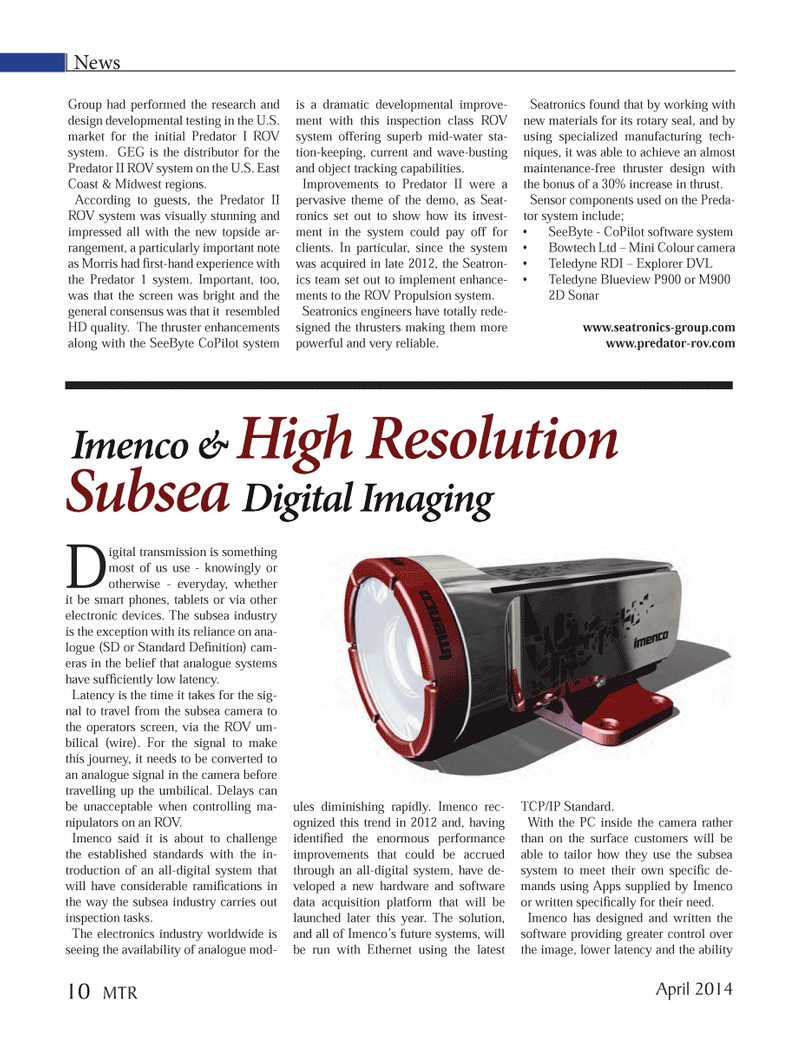
Page 10: of Marine Technology Magazine (April 2014)
Offshore Energy
Read this page in Pdf, Flash or Html5 edition of April 2014 Marine Technology Magazine
News
Group had performed the research and design developmental testing in the U.S. market for the initial Predator I ROV system. GEG is the distributor for the
Predator II ROV system on the U.S. East
Coast & Midwest regions.
According to guests, the Predator II
ROV system was visually stunning and impressed all with the new topside ar- rangement, a particularly important note as Morris had fi rst-hand experience with the Predator 1 system. Important, too, was that the screen was bright and the general consensus was that it resembled
HD quality. The thruster enhancements along with the SeeByte CoPilot system is a dramatic developmental improve- ment with this inspection class ROV system offering superb mid-water sta- tion-keeping, current and wave-busting and object tracking capabilities.
Improvements to Predator II were a pervasive theme of the demo, as Seat- ronics set out to show how its invest- ment in the system could pay off for clients. In particular, since the system was acquired in late 2012, the Seatron- ics team set out to implement enhance- ments to the ROV Propulsion system.
Seatronics engineers have totally rede- signed the thrusters making them more powerful and very reliable.
Seatronics found that by working with new materials for its rotary seal, and by using specialized manufacturing tech- niques, it was able to achieve an almost maintenance-free thruster design with the bonus of a 30% increase in thrust.
Sensor components used on the Preda- tor system include; • SeeByte - CoPilot software system • Bowtech Ltd – Mini Colour camera • Teledyne RDI – Explorer DVL • Teledyne Blueview P900 or M900 2D Sonar www.seatronics-group.com www.predator-rov.com
D igital transmission is something most of us use - knowingly or otherwise - everyday, whether it be smart phones, tablets or via other electronic devices. The subsea industry is the exception with its reliance on ana- logue (SD or Standard Defi nition) cam- eras in the belief that analogue systems have suffi ciently low latency.
Latency is the time it takes for the sig- nal to travel from the subsea camera to the operators screen, via the ROV um- bilical (wire). For the signal to make this journey, it needs to be converted to an analogue signal in the camera before travelling up the umbilical. Delays can be unacceptable when controlling ma- nipulators on an ROV.
Imenco said it is about to challenge the established standards with the in- troduction of an all-digital system that will have considerable ramifi cations in the way the subsea industry carries out inspection tasks.
The electronics industry worldwide is seeing the availability of analogue mod- ules diminishing rapidly. Imenco rec- ognized this trend in 2012 and, having identifi ed the enormous performance improvements that could be accrued through an all-digital system, have de- veloped a new hardware and software data acquisition platform that will be launched later this year. The solution, and all of Imenco’s future systems, will be run with Ethernet using the latest
TCP/IP Standard.
With the PC inside the camera rather than on the surface customers will be able to tailor how they use the subsea system to meet their own specifi c de- mands using Apps supplied by Imenco or written specifi cally for their need.
Imenco has designed and written the software providing greater control over the image, lower latency and the ability
Imenco & High Resolution
Subsea Digital Imaging
April 2014 10 MTR
MTR #3 (1-17).indd 10 4/9/2014 12:28:28 PM

 9
9

 11
11
